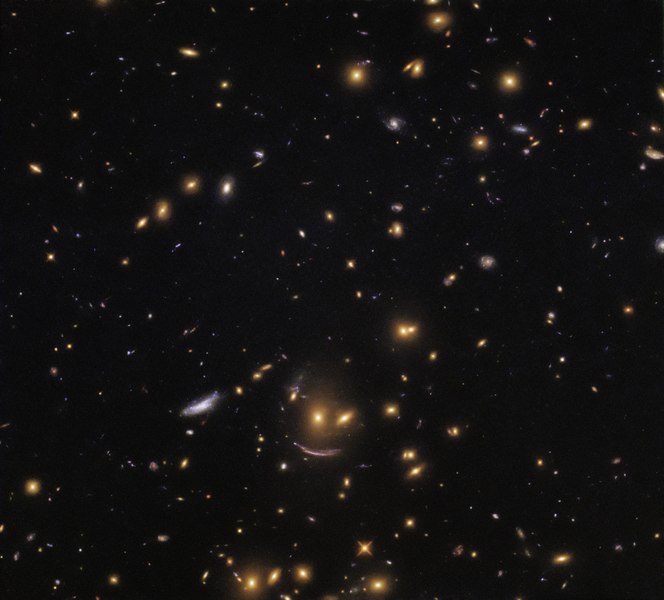Usòrò:On the hunt for newborn stars.tif

Failụ si na nke mbu (3,425 × 3,093 pixel, ívù akwukwo orunótu: 19.53 MB, MIME nke: image/tiff)
Failụ a si na Wikimedia Commons,enwekwara ike iji ya eme ihe na arụmarụ ọzọ. Nkọwa na ihuakwukwọ nkọwa failụ eziri na okpuru.
Mmẹkụwátá
| NkówáOn the hunt for newborn stars.tif |
English: This image, taken with the NASA/ESA Hubble Space Telescope's Wide Field Camera 3 (WFC3), shows a patch of space filled with galaxies of all shapes, colours, and sizes. WFC3 is able to view many such galaxies at an unprecedented resolution — high enough to locate and study regions of star formation in a bid to understand how new stars spring to life throughout the cosmos.
Stars are born within giant clouds of gas. These massive clouds, or stellar nurseries, grow unstable and begin to collapse under gravity, becoming the seeds that will grow into new stars. By analysing the luminosity, size, and formation rate of different stellar nurseries, scientists hope to learn more about the processes that can lead to the formation of a newborn star. Studying nurseries within different galaxies will provide information about star formation at different points in time and space throughout the Universe. Just below centre in this image is a formation of galaxies akin to a smiling face! Two yellow-hued blobs hang atop a sweeping arc of light, forming a celestial object known as SDSSJ0952+3434. The lower, arc-shaped galaxy has the characteristic shape of a galaxy that has been gravitationally lensed — its light has passed near to a massive object en route to us, causing it to become distorted and stretched out of shape. |
| Ǹgụ́ụ̀bọ̀chị̀ | |
| Mkpọlọ́gwụ̀ | https://www.spacetelescope.org/images/potw1842a/ |
| Odé ákwụ́kwọ́ |
ESA/Hubble & NASA Acknowledgement: Judy Schmidt (geckzilla) |
Nkwényé
| ESA/Hubble images, videos and web texts are released by the ESA under the Creative Commons Attribution 4.0 International license and may on a non-exclusive basis be reproduced without fee provided they are clearly and visibly credited. Detailed conditions are below; see the ESA copyright statement for full information. For images created by NASA or on the hubblesite.org website, or for ESA/Hubble images on the esahubble.org site before 2009, use the {{PD-Hubble}} tag.
Conditions:
Notes:
|
- I wepulara nóru:
- i nye – ikọpị,ikekasi na izịpụ ọru a
- i dowaria – igbanwee ọrụ a
- Ọ ga bụ na ọnọdụ ndi a:
- í-kpó-áhà – Ị ga-enyerịrị ugo kwesịrị ekwesị, nye njikọ na ikikere ahụ, ma gosikwa ma emere mgbanwe. Ị nwere ike ime ya n'ụzọ ezi uche ọ bụla, mana ọ bụghị n'ụzọ ọ bụla na-egosi na onye nyere ikikere kwadoro gị maọbụ ojiji gị.
Nkowapụta
Ihe ndị egosiri na faịlụ a
depicts Bekee
copyright status Bekee
copyrighted Bekee
15 Ọktoba 2018
Ịta nke usòrò
Bìri èhì/ogè k'ị hụ òtù ụ̀fa dị̀ m̀gbè ahụ̀.
| Èhì/Ogè | Mbọ-aka | Ógólógó na asaá | Òjìème | Nkwute | |
|---|---|---|---|---|---|
| dị ùgbu â | 14:28, 15 Ọktoba 2018 |  | 3,425 × 3,093 (19.53 MB) | Jmencisom | User created page with UploadWizard |
Ojiji faịlụ
Ihe ndị na-eso ihe eji Ihu akwụkwọ eme na faịlụ a:
Ejiji failụ zụrụ ọha
Wikis ndi a edeputara na eji kwa failụ a:
- Ihe eji na el.wikipedia.org
- Ihe eji na en.wikipedia.org
Ómárí nso
Usòrò á nwèrè ụmà nke ozor, ọ ga dí na ȯ byàrà shí nsé nhuunuche nsónùsòrò mà ihe njè nsónùsòrò nke kéré mà nké tonyèrè ya na nsónùsòrò.
Ȯ bụ nà usòrò à gabnwere shí òtù ȯ di nà mgbe mbu, ótù ụmà àgághị è zí ya.
| Àsáa | 3,425 px |
|---|---|
| Ógólógó | 3,093 px |
| Bits per component |
|
| Compression scheme | LZW |
| Pixel composition | RGB |
| Ívú nà àsáa | Nkịtị |
| Number of components | 3 |
| Number of rows per strip | 25 |
| Mkpebi gbara uhie | 72 dpi |
| Mkpebi kwụọ ọtọ | 72 dpi |
| Data arrangement | chunky format |
| Ndiriusòrò ejìème | Adobe Photoshop CC (Windows) |
| Failụ mgbanwe ụbọchi na oge | 15:35, 9 Febụwarị 2018 |
| Ámá àgwà | Uncalibrated |
| warning | identify: Incompatible type for "RichTIFFIPTC"; tag ignored. `TIFFFetchNormalTag' @ warning/tiff.c/TIFFWarnings/912. |


